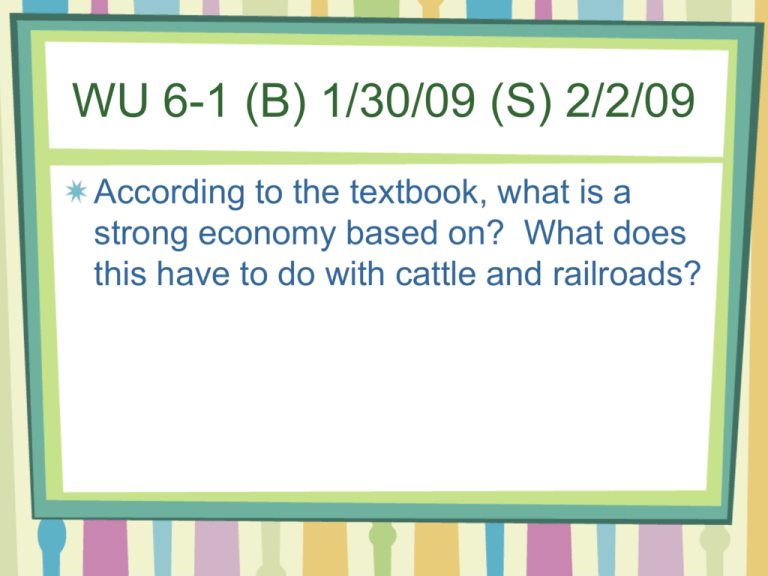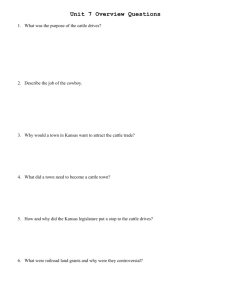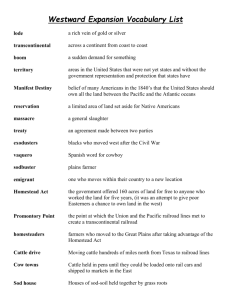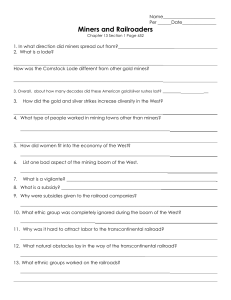Why did towns want to attract cattle trade?
advertisement

WU 6-1 (B) 1/30/09 (S) 2/2/09 According to the textbook, what is a strong economy based on? What does this have to do with cattle and railroads? Unit 6: Cattle and Railroads (B) 1/30/09 (S) 2/2/09 "Get Along Little Dogies" As I was a walkin' one morning for pleasure, I spied a cow puncher a riding along. His hat was thrown back and his spurs was a jinglin', And as he approached he was singing this song » REFRAIN Whopee tie yi yo, git along little dogies. It's my misfortune and none of your own. Whopee tie yi yo, git along little dogies. For you know Wyoming will be your new home. It's early in spring time that we round up the dogies. We mark 'em and brand 'em and bob off their tails. We round up the horses, load up the chuck wagon, And then drive the dogies out on the long trail. Cowboy Boots Spurs Chaps Gloves Wipe (bandanna) Hat What was the job of the cowboy? The Real American Cowboy WU 6-2 (B) 2/3/09 (S) 2/4/09 • Name two reasons why cattle were brought to Kansas from Texas. Cattle Drives 1867 to mid-1880s Longhorns driven to Kansas from Texas. Open range Three Major Trails – Shawnee – Chisholm Longhorn • San Antonio, TX to Abilene, KS • Kansas Pacific Railroad – Western • Bandera TX to Dodge City, KS What was the purpose of cattle drives? Jesse Chisholm Purpose of Cattle Drives Shortage of beef in the eastern United States, yet the demand was high. Cattle herds had expanded rapidly due to them running wild. People began rounding up wild Texas cattle and taking them east to sell. Purpose (continued) Cattle were worth more in the east than in Texas. Cattle had to be moved to where the people lived so the meat would remain fresh. Video Cattle Trails Video Video Attracting Cattle Trade Make money from the cattle drives. Cowboys paid at the end of the trail Local businessmen bought and sold cattle for a profit. Towns wanted to prove they were the best site for selling and shipping cattle. Why did towns want to attract cattle trade? Cattle Towns Located on a railroad line The point where the cattle were shipped east. Why did a town need to become a cattle town? What Ended The Cattle Drives? •Settlers built fences •Barbed wire first used on open range in 1874. End of Cattle Trails from Texas to Kansas •Diseases from Texas cattle •Kansas Legislatures passed law prohibiting infected cattle in Kansas. •Quarantine line restricted cattle Railroads into Texas Kansas Legislature End Cattle Drives Legislatures passed laws to keep cattle drives did out of Kansas. Why the Kansas Legislature One law prohibited infected cattle from put a stop to the cattle drives? entering the state. Quarantine Line – Law amended to restrict all Texas cattle to land west of McPherson. – Moved to southwest border of KS The Last Cowboy Song Class Activity: Mapping the Cowtowns and Railroads in Kansas At one time, railroads and cattle trails crisscrossed the state of Kansas To give you some idea of how extensive the rails and cowtowns were, map the routes of several railroads through Kansas and locations of cattle trade.. A list of Kansas railroads with information on their routes can be found at: http://www.ku.edu/heritage/research/rr/railroads.html To do this mapping exercise, you will need… – Blank map of Kansas – Map of Kansas that locates cities and towns – List of towns Directions: – Label the towns on the map – Draw and label the railroads and trails through Kansas Railroad Land Grants Federal government gave public lands to railroad companies in exchange for building tracks in specific locations. U.S. government surveyed the public lands and divided them into one-mile square sections. Railroads received every other section. Railroad Land Grants (cont.) Grants controversial – Had monopoly in specific regions. – Make a profit shipping goods to and from communities in these areas. – Receiving too much of a subsidy. Railroads Sell Land Growth of towns along the rail lines resulted in profits for the railroad. The closer people lived to a railroad line, the more they would use the railroads services. The railroads also could make money selling their land grants so they competed for business. Town Site Association Surveyed the lands Planned the selected town sites Sold shares in the town sites to pay for land surveys Railroads Bring Businesses More profitable to encourage several smaller specialized stores in a central location rather than one general store More business lots could be sold “The Rain Follows the Plow” Cultivation of the land could and would change the climate. As the plow broke the sod, the rainfall would increase. Crops in Kansas Corn Oats Cotton Tobacco Rye Barley flax Castor beans Hemp Broomcorn Grapes Fruit orchards Wheat Farming Subsistence – provided food for the farmer’s family Commercial – Having surplus products to sell By late 1800s, most farmers grew crops to sell, while at the same time growing gardens to feed their family. Mechanization Saved time Need for less hired help Grain-drilling machines helped farmers to plant seeds. Mechanical reaper was pulled through the field cutting the stalks of grain. Mechanical threshing helped farmers separate the grain from the straw. Grange Movement National organization that brought farmers together. Started for social and cultural reasons. Promoted education among farmers Offered the chance for farmers to associate with other farmers who might share common concerns. Started to represent the political needs of the farmer. Job of the Cowboy Age: Early 20s Made $24-$40 a month Took care of the cattle, driving them north to the railroad lines in Kansas. Traveled 750 miles on the trail for more than 30-40 days. Spent 18 hours a day on a horse.









